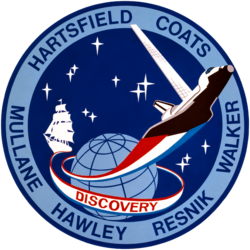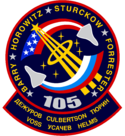Sts-78-patch
The STS-78 patch links past with present to tell the story of its mission and science through a design imbued with the strength and vitality of the 2-dimensional art of North America's northwest coast Indians. Central to the design is the space Shuttle whose bold lines and curves evoke the Indian image for the eagle, a native American symbol of power and prestige as well as the national symbol of the United States. The wings of the Shuttle suggest the wings of the eagle whose feathers, indicative of peace and friendship in Indian tradition, are captured by the U forms, a characteristic feature of Northwest coast Indian art. The nose of the Shuttle is the strong downward curve of the eagle's beak, and the Shuttle's forward windows, the eagle's eyes, represented through the tapered S forms again typical of this Indian art form.
The basic black and red atoms orbiting the mission number recall the original NASA emblem while beneath, utilizing Indian ovoid forms, the major mission scientific experiment package LMS (Life and Materials Sciences) housed in the Shuttle's cargo bay is depicted in a manner reminiscent of totem-pole art. This image of a bird poised for flight, so common to Indian art, is counterpointed by an equally familiar Tsimshian Indian symbol, a pulsating sun with long hyperbolic rays, the symbol of life. Within each of these rays are now encased crystals, the products of this mission's 3 major, high-temperature materials processing furnaces. And as the sky in Indian lore is a lovely open country, home of the Sun Chief and accessible to travelers through a hole in the western horizon, so too, space is a vast and beckoning landscape for explorers launched beyond the horizon.
Beneath the Tsimshian sun, the colors of the earth limb are appropriately enclosed by a red border representing life to the Northwest coast Indians. The Indian colors of red, navy blue, white, and black pervade the STS-78 path. To the right of the Shuttle-eagle, the constellation Delphinus recalls the dolphin, friend of ancient sailors and, now perhaps too, of the 9 space voyagers suggested by this constellation's blaze of 9 stars. The patch simultaneously celebrates international unity fostered by the Olympic spirit of sports competition at the 1996 Olympic Games in Atlanta, Georgia, U.S.A. Deliberately poised over the city of Atlanta, the Space Shuttle glows at its base with the 5 official Olympic rings in the 5 Olympic colors which can also be found throughout the patch, rings and colors which signify the 5 continents of the earth. This is an international mission and for the first time in NASA patch history, astronauts have dispensed with identifying country flags beneath their names to celebrate the spirit of international unity so characteristic of this flight.Relevante Bilder
Relevante Artikel
STS-78STS-78 ist eine Missionsbezeichnung für den US-amerikanischen Space Shuttle Columbia (OV-102) der NASA. Der Start erfolgte am 20. Juni 1996. Es war die 78. Space-Shuttle-Mission und der 20. Flug der Raumfähre Columbia. .. weiterlesen
Liste der Space-Shuttle-MissionenDie folgende Liste der Space-Shuttle-Missionen führt die Starts des US-amerikanischen Space-Shuttle-Programms chronologisch auf. Alle Space-Shuttle-Starts erfolgten bemannt und wurden von der NASA durchgeführt. Alle Starts erfolgten vom Kennedy Space Center (KSC) von den Startanlagen LC-39A und LC-39B. Ab 2007 wurde nur noch LC-39A benutzt. .. weiterlesen
Columbia (Raumfähre)Die Raumfähre Columbia war das erste weltraumtaugliche Space Shuttle der NASA und das erste wiederverwendbare Raumfahrzeug. Im März 1979 fertiggestellt, fand der Jungfernflug am 12. April 1981 statt (STS-1). Die interne Bezeichnung lautet OV-102, wobei OV für Orbiter Vehicle steht. Sie brach am 1. Februar 2003 bei ihrem 28. Weltraumeinsatz beim Wiedereintritt in die Erdatmosphäre auseinander, wobei alle sieben Besatzungsmitglieder ums Leben kamen. .. weiterlesen










































